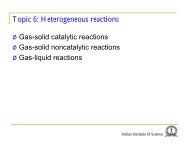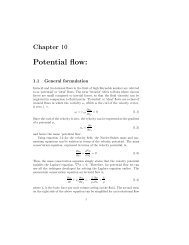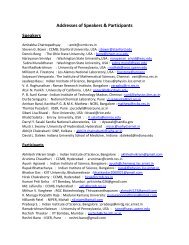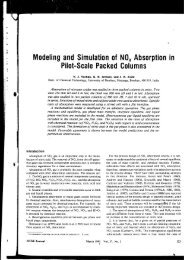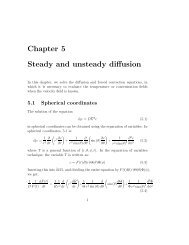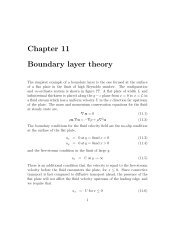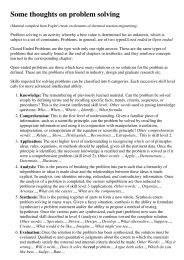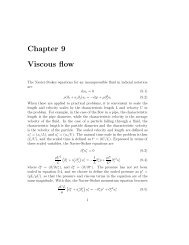Chapter 3 Unidirectional transport - Chemical Engineering ...
Chapter 3 Unidirectional transport - Chemical Engineering ...
Chapter 3 Unidirectional transport - Chemical Engineering ...
- No tags were found...
Create successful ePaper yourself
Turn your PDF publications into a flip-book with our unique Google optimized e-Paper software.
3.3. EFFECT OF PRESSURE ON MOMENTUM TRANSPORT 31equation for the x component of the momentum can be written as,Rate of changeof x momentum= Sum of forces l (3.119)The rate of change of momentum in a time interval ∆t within the differentialvolume under consideration can be written as,Rate of changeof x momentum = ∆(ρu x)(2πr∆r∆z (3.120)∆twhere ∆(ρu x ) is the change in the momentum per unit volume in the timeinterval ∆t.There are four bounding surfaces for the differential volume under consideration,two or which are at perpendicular to the x axis and located atx and x + ∆x, and two of which are perpendicular to the radial co-ordinateand are located at r and r + ∆r. The forces acting on the surfaces at x andx + ∆x can be separated into two parts, the first due to the pressure actingon the surfaces, and the second due to the flux of momentum due to fluidmotion. The forces due to fluid pressure can be written as,Force due to pressureon surface at xForce due to pressureon surface at x + ∆x= p(r, θ, x)(2πr∆r)= −p(r, θ, x + ∆x)(2πr∆r) (3.121)Note that there is a negative sign for the force at x+∆x, because the pressurealways acts along the inward unit normal at the surface, and the inward unitnormal at x + ∆x is in the negative x direction. There is an additional forcedue to the flow of momentum into the differential volume through the surfaceat x and the flow of momentum out of the differential volume through thesurface at x + ∆x. This force is given by the product of the momentum flux(momentum <strong>transport</strong>ed per unit area per unit time) and the surface area.The momentum flux is the product of the momentum density (ρu x ) (per unitvolume) and the normal velocity to the surface u x . This is analogous to themass flux, which is the product of the concentration (mass density) c andthe normal velocity. Therefore, the force due to the flow of momentum is,Force due to momentum flowon surface at xForce due to momentum flowon surface at x + ∆x= ((ρu x )u x (2πr∆r)= −p(r, θ, x + ∆x)(2πr∆r)(3.122)



